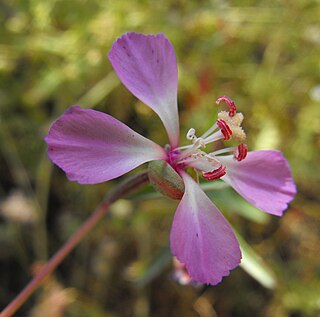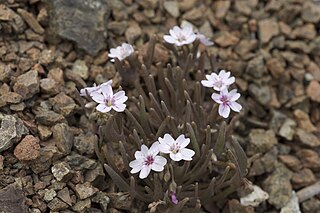
Clarkia is a genus within the flowering plant family Onagraceae. Over 40 species are currently classified in Clarkia; almost all are native to western North America, though one species is native to South America.
Clarkia affinis is a species of wildflower known as chaparral clarkia. It is endemic to California, where it grows mainly on chaparral slopes and woodlands in the Coast Ranges. This is a spindly plant producing erect stems exceeding half a meter in height and sparse narrow leaves. The flower is a bowl-shaped bloom with four pink or red petals each 5 to 15 millimeters long. The petals may have darker spots near the base and purple or red speckling.
Cleome sparsifolia is a species of cleome known by the common names fewleaf cleome and fewleaf spiderflower. This annual wildflower is native to California and Nevada where it grows in desert sand. This is an erect, branching plant not exceeding a meter in height. Its sparse leaves are each made up of 3 thick, oval-shaped leaflets. The bright yellow flowers have curving petals and long stamens tipped with knobby anthers. The fruit is a capsule up to 4 centimeters long.

Clarkia davyi is a species of flowering plant in the evening primrose family known by the common name Davy's fairyfan, or Davy's clarkia. It is endemic to California, where it grows in coastal habitats such as beaches and bluffs. This is an annual herb producing a thin stem which grows along the ground or somewhat upright. It is lined with small oval-shaped leaves one or two centimeters long. While in bud the flower is enclosed in four fused thick sepals. It blooms into a petite bowl-shaped corolla of four pink petals which often have lighter bases. Each petal is 5 to 11 millimeters long.
Chylismia heterochroma is a species of evening primrose known by the common name Shockley's evening primrose. It is native to the desert slopes and woodland of eastern California and Nevada. It is a hairy, glandular annual herb growing a spindly stem up to a meter tall. There is a thick basal rosette of leaves which are mostly oval in shape and several centimeters in length, and generally no leaves higher up the stem. The inflorescence produces several small flowers with four oval petals just a few millimeters long and lavender in color with yellow-tinted bases. The fruit is a club-shaped capsule roughly a centimeter long.
Camissoniopsis intermedia is a species of evening primrose known by the common name intermediate suncup. It is native to California and Baja California, where it grows on the slopes of coastal and inland hills and mountains, especially in areas that have recently burned. It is an annual herb producing an erect, hairy stem up to about half a meter in height. Most of the leaves are located in a basal rosette at ground level and are oval to lance-shaped and up to 12 centimeters in length. The hairy, nodding inflorescence produces flowers with yellow petals just a few millimeters in length. The petals have one or two red dots at their bases. The fruit is a straight or coiling, wormlike capsule up to 2.5 centimeters long.
Campanula californica is a species of flowering plant in the bellflower family Campanulaceae, known by the common names swamp bellflower and swamp harebell. It is endemic to California, where it grows along the coastline between Marin and Mendocino Counties. It is found mainly in wet areas such as bogs, marshes, and wet forest floors. This is a hairy rhizomatous perennial herb producing a thin, creeping stem 10 to 30 centimeters long. The thin, rippled leaves are oval in shape and between 1 and 2 centimeters long. The bell-shaped flower is pale blue with curving petals up to 1.5 centimeters long. The fruit is a ribbed, spherical capsule.
Caulanthus glaucus is a species of flowering plant in the family Brassicaceae known by the common name glaucous wild cabbage.
Clarkia borealis is a rare species of flowering plant in the evening primrose family known by the common name northern clarkia. It is endemic to California, where it is known from the forests of the southern Klamath Range and the southernmost Cascade Range foothills. It is an annual herb growing an erect, slender stem. The leaves are oval in shape and borne on short petioles. The top of the stem is occupied by the inflorescence, in which the lowest flowers open first and hanging, pointed flower buds occur at nodes at the top. The sepals separate as the flower blooms, revealing purplish pink petals. Each petal is between 1 and two centimeters long, elongated triangular to semicircular in shape, and sometimes flecked with dark purple. There are 8 stamens with anthers bearing blue-gray pollen, and a protruding stigma.

Clarkia delicata is a rare species of flowering plant in the evening primrose family known by the common names Campo clarkia and delicate clarkia. It is native to northern Baja California and adjacent San Diego County, California, where it grows in the woodland and chaparral of the Peninsular Ranges. This is an annual herb producing an erect stem just over half a meter in maximum height. The leaves are oval or widely lance-shaped, up to 4 centimeters long, and borne on very short petioles. The top of the stem is occupied by the inflorescence, in which the lower flowers open while the upper buds hang closed. The sepals remain fused as the flower blooms from one side. Each unlobed oval petal is about a centimeter long and pink to pinkish-lavender. There are 8 stamens, some with large orange anthers and some with smaller, paler anthers. There is also a protruding stigma with four large, fuzzy lobes.

Clarkia epilobioides is a species of flowering plant in the evening primrose family known by the common name canyon clarkia. It is native to California, Arizona, and Baja California, where it grows in shaded habitat in woodland and chaparral. It is an annual herb producing a slender, erect stem sometimes exceeding half a meter in height. The leaves are narrowly to widely lance-shaped and less than 3 centimeters long. The top of the stem is occupied by the inflorescence. Each hanging bud has four red sepals which remain fused all together or in pairs as the petals emerge during blooming. The petals are one half to one centimeter long, oval in shape, solid white or cream in color, often fading pink as they age. There are eight protruding stamens and one stigma.

Clarkia exilis is a small herbaceous annual plant of western North America. It is an uncommon species in the evening primrose family known by the common names Kern River clarkia and slender clarkia.
Clarkia heterandra is a species of flowering plant in the evening primrose family known by the common name mountain clarkia. It is endemic to California, where it is from the forests and woodlands of several of eastern and western mountain ranges. It is an annual herb producing an erect, glandular stem to around half a meter in maximum height. The lance-shaped to oval leaves are up to 8 centimeters long and are borne on petioles of up to 2 centimeters. The top of the stem is occupied by the inflorescence, with open flowers and closed buds. The sepals remain fused as the flower blooms from one side. The pink petals are oval in shape and just a few millimeters long. There are 8 stamens, some large and some small and sterile. The fruit is a small, hard body 2 or 3 millimeters long containing 1 or 2 seeds.

Clarkia mildrediae is an uncommon species of flowering plant in the evening primrose family known by the common name Mildred's clarkia. It is endemic to California, where it is known from the forests of the southernmost Cascade Range and northern Sierra Nevada. It is an erect annual herb often exceeding half a meter in height. The oval leaves grow up to 6 centimeters long and are borne on petioles of up to 4 centimeters. The inflorescence bears opening flowers and hanging, pointed flower buds. As the bud opens the sepals all separate instead of remaining fused as those of many other Clarkia species do. The triangular to semicircular petals are about 2 centimeters long and lavender to bright reddish-purple, sometimes with dark speckling. There are 8 stamens with anthers all alike, and a protruding stigma.

Clarkia modesta is a species of flowering plant in the evening primrose family known by the common name Waltham Creek clarkia. It is endemic to California, where it is known from the woodlands of several of the central mountain ranges, including the North and Central Coast Ranges and the Sierra Nevada foothills. It is an erect annual herb often exceeding half a meter in height. The oval, linear, or lance-shaped leaves are 2 to 4 centimeters long. The inflorescence bears opening flowers and closed, hanging flower buds. The sepals remain fused as the petals bloom from one side. The petals are about a centimeter long and vary in shape from diamond to widely lance-shaped. They are pale to deep pink and generally dark-flecked or spotted.

Clarkia mosquinii is a rare species of flowering plant in the evening primrose family known by the common name Mosquin's clarkia. It is endemic to California, where it is known only from the northern Sierra Nevada foothills at the border between Butte and Plumas Counties. It was thought to be extinct until it was rediscovered in 1991. It is an erect annual herb often exceeding half a meter in height. The oval or lance-shaped leaves are 2 to 5 centimeters long. The inflorescence bears opening flowers below a series of clusters of closed, hanging flower buds. The sepals all separate as the flower blooms. The diamond-shaped petals are one to two centimeters long light to medium purple in color, and sometimes speckled with reddish purple.
Clarkia similis is a species of flowering plant in the evening primrose family known by the common name Ramona clarkia. It is endemic to California, where it is known from the coastal hills and mountains of the southwestern part of the state. It is an annual herb growing erect, approaching a meter in maximum height. The inflorescence bears open flowers and closed, hanging flower buds. The sepals remain fused as the petals bloom from one side. The petals are less than a centimeter long and oval to diamond in shape. They are pale pink with white near the bases, and sometimes purple-speckled.
Clarkia tembloriensis is a rare species of flowering plant in the evening primrose family, known by the common name Temblor Range clarkia and belonging to the Onagraceae family.

Clarkia virgata is a species of flowering plant in the evening primrose family known by the common name Sierra clarkia. It is endemic to California, where it is known from the forests and woodlands of the Sierra Nevada.

Claytonia gypsophiloides, known by the common names gypsum springbeauty and Coast Range claytonia, is a species of wildflower in the family Montiaceae.










